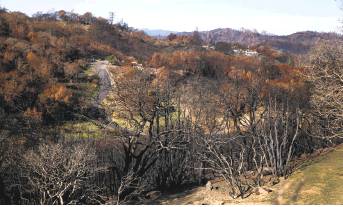Forests struggle to recover from fires
New vegetation even more at risk
By Kurtis Alexander
As hotter and bigger fires blaze through the West and yet another year passes with a disastrous toll, America’s wildlands are having a harder time bouncing back. Some spots, from the singed valleys of Wine Country to the steep slopes of the Sierra, may never look the same.
The fiercer fires are killing more of the vegetation needed to provide seeds for regrowth, and scientists are learning that even when new trees sprout, many are struggling with the warmer and more extreme weather wrought by climate change.
While wildfires have historically benefited the natural landscape, cycling soil nutrients and clearing space for new plants, for example, scientists say more burned areas are likely to end up devoid of trees and populated instead with weeds and grasses. This new vegetation is even likelier to burn, setting in place a vicious cycle of only more fire and less forest.
The latest research on forest regeneration, published in December in the journal Ecology Letters, found that as much as one-third of the areas burned since 2000 saw no trees return — about double the tree-less land that resulted after fires before 2000.
In 54 percent of the areas burned this century, the research suggests too few trees grew back to ensure a full forest recovery.
“We need to start expecting that these landscapes aren’t going to look the same in the future, whether it’s reduced density of trees or no longer a forest,” said the study’s lead author, Camille Stevens-Rumann, an assistant professor of forest and rangeland stewardship at Colorado State University.
The study looked at nearly 1,500 sites that burned between 1985 and 2015 across five mountain states. California was not included, but Stevens-Rumann said her findings have broader implications.
“Regardless of whether you have a chaparral ecosystem burning in Southern California or a forest ecosystem in the Sierra, there’s always a concern about whether they’re going to bounce back from a wildfire,” she said. “Many areas are not bouncing back as they have.”
Stevens-Rumann and her fellow researchers blame warmer temperatures and prolonged dry periods for the greater difficulty that seedlings are having after fires.
In the past, new trees would typically sprout within two to three years. The researchers expect forest regeneration rates to continue to slip in coming decades while “alternative shrubs or grassland states” take hold.
Last year’s extraordinary fire season, which burned 9.6 million acres nationwide and 1.2 million acres in California, has set the stage for more such changes.
Kristen Shive, a forest ecology researcher at UC Berkeley who was not involved in the new study, said some woodlands that burned last summer in the Sierra, especially at warmer, lower elevations, probably will not return as they were, including parts of Yosemite National Park.
“Here we’re already seeing some transition to shrub-lands,” she said.
Beyond climate change, forest recovery is being hurt by more intense fires destroying trees and their seed source, Shive said, meaning less chance of reproduction.
These larger, hotter fires are driven by both the warming planet and decades of fire suppression, which has left a surplus of flammable vegetation. Before firefighting, the forests would naturally burn, reducing the fuel buildup.
The massive 2013 Rim Fire on the edge of Yosemite left so much land barren of trees and seeds that scientists say it could be centuries before the forests recover, if they ever do.
While the wild areas that burned in October’s Wine Country firestorm — the most destructive in California history — were generally less woodsy and more prairie-like than the Sierra, Shive said the North Bay’s scorched forests, consisting mostly of Douglas fir, could face similar hurdles.
“In the Sonoma County area, where there were patches of really high-burn severity, the trees may come back more slowly,” she said.
As for the grasslands and chaparral, which describe much of the land charred last year both in Wine Country and Southern California, the vegetation is typically more resilient to fire and better able to regenerate.
But problems can arise. Unlike in the Sierra, where fire has been too infrequent, the coast has sometimes burned too much, especially farther south, said Hugh Safford, ecologist for the U.S. Forest Service’s Pacific Southwest Region. The result, he said, is that even the low-growing, fire-adapted vegetation is forced out.
“If you burn it too often, you make it impossible” for vegetation to come back, he explained. “If you’re driving around Southern California, there aren’t any shrubs on those hillsides anymore. It’s just weeds.”
The Thomas Fire, which started Dec. 4 before exploding into the state’s largest recorded wildfire at more than 280,000 acres, continued to smolder last week on many of the weed-covered slopes of Ventura and Santa Barbara counties. Invasive plants overtaking these areas, Safford warned, make the landscape even more prone to burning.
Changes in overall “fire regimes,” he said, “have significant impact on the ecosystem — and people’s ability to safely live within them.”
Kurtis Alexander is a San Francisco Chronicle staff writer. Email: kalexander@sfchronicle.com Twitter: @kurtisalexander
“If you burn it too often, you make it impossible” for vegetation to come back.
Hugh Safford, U.S. Forest Service
